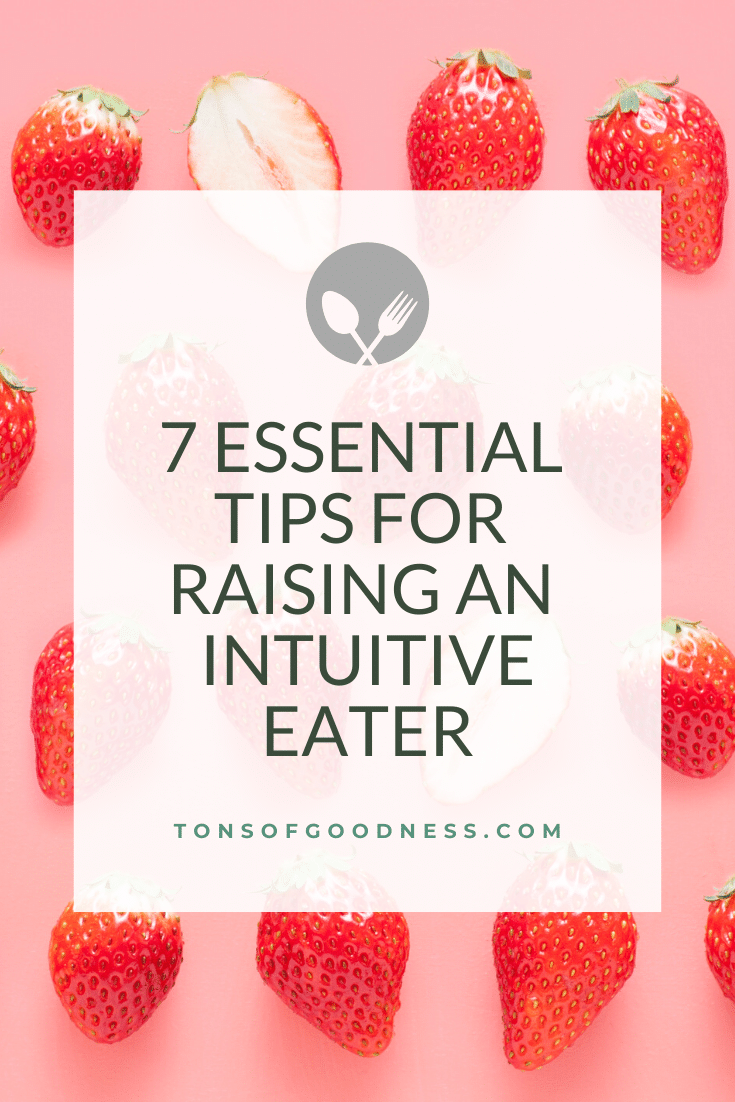

Disclosure: Some of the links in this article are affiliate links, which means that if you purchase through those links I will receive a small commission. For example, as Amazon Associate, I earn from qualifying purchases. If you decide to use these links, thank you!
We all want our kids to eat healthy foods…or just to eat something at mealtimes. It can cause stress for us as parents when our child plays with their food or just eats bread and leaves everything else on the plate.
It causes stress because we care. We don’t want our kids to be hungry. And we want them to get the nutrients they need for their health. Yet, what most people don’t know is that kids have an amazing way of knowing how much and what they need to eat.
By following the basic intuitive eating principles you will be able to help your child develop a healthy relationship with food. At the same time, you will begin to feel less stressed about mealtime.
For more information about how to develop intuitive eating principles as an adult, please read this article:
A Simple Way to Get Started with Intuitive Eating

So, what exactly is an intuitive eater? Intuitive eaters eat when they are hungry, eat without guilt, and listen to their body’s signals to tell when they are full. Intuitive eaters also eat foods that they enjoy and are satisfied after they eat.
The thing is that we are all born as intuitive eaters. As infants, we cry when we are hungry and we are fed. When an infant is full they will turn away. In addition, studies show that toddlers are able to regulate their eating according to what their bodies need for growth (source). This means that even when a child appears to be eating sporadically, the amount of food and nutrition they are getting is balanced over time.
Unfortunately, as children get older, messages and rules about food can interfere with our ability to eat intuitively. These messages range from commercials about brightly colored cereals to rules at home, such as having to “clean your plate” before you can leave the table. These messages are confusing to kids and over time will change how they view eating.
As parents, there are actions that we can take to support our child’s ability to eat intuitively. These are a few tips to get you started:

During snack and mealtimes, our role as a parent is to provide food for our child and then let the child decide how much they want to eat and what they will eat from the foods provided. This intuitive eating principle is based on the Division of Responsibility, created by Ellyn Satter, a renowned dietitian and family therapist.
It may be stressful for you at first to see your child leave their plate essentially untouched at mealtimes. Or, to see your child eat only one of the foods provided. However, kids are able to regulate how much food they really need (source). Without the pressure to eat, they can decide how much they need and stop eating when they are full.
It can be tempting to encourage our child to take “two more bites” or “clean their plate”. However, by doing this you are telling them that you don’t trust their ability to listen to their fullness. This can lead to a lifetime of overeating, while also increasing anxiety around mealtime.
By providing your child the ability to choose how much they want to eat, you can ultimately help them to have a better relationship with food and eating.
Play foods are candy, sweet drinks, and packaged foods like chips. For very young children there is not a need to introduce play foods. However, when they are a bit older and more aware of candy and other foods, do your best to allow your child to eat the food without restriction. The goal of this intuitive eating principle is to think of play foods as ordinary foods instead of as treats.
This is because studies show that restricting foods (whether it’s a healthy or unhealthy food), does not encourage moderate patterns of intake (source). In fact, restriction leads to a higher desire and intake of foods once the restricted food is available (source). It has also been found that the effects of restriction on children’s eating behavior are more apparent in homes where foods are consistently restricted (source).
What does this look like on a daily basis?
Offer play foods at mealtimes at least once per day. This means that it’s okay to go ahead and put the cookies on the plate at dinner time. Kids can eat the play food at any time they want during the meal. And they do not have to eat other foods first before they eat the play food.
But won’t your child eat the play food first? Yes, they probably will at first because this is new and exciting to them. Yet, over time the newness will wear off and they will see it just as another food for dinner.
Remember that this is a process, not a quick fix. It’s going to take time and patience. But, if you trust the process both you and your child will benefit.

It’s our job as parents to serve a variety of foods including protein, fats, fruits, and vegetables. Yet, there are going to be some foods that your child doesn’t like. Or, your child may be hesitant about trying new foods. Both cases are normal developmentally, and there are a few things that we can do to introduce new foods in a positive way.
One way is to serve the food from time to time without commenting on the food. Studies show that children are more likely to eat new food, or any food if there is no pressure to eat (source).
So, we as parents need to do our best to avoid pressure, whether it’s positive or negative. Positive pressure could be encouraging comments or rewards while negative pressure could look like withholding activities, criticizing, and physically forcing the child to eat.
Another helpful way to introduce new foods is to let your child play with the food. For example, a study of young children demonstrated that hands-on activities enhanced the children’s willingness to taste unfamiliar fruits and vegetables (source). Some children will touch and play with the food and that’s a great first step.
Another option is to prepare the food in a new way. For example, my daughter doesn’t like raw carrots, but she likes them steamed. You could also have your child help you to prepare the food. Young children love to help in the kitchen.
According to Evelyn Tribole, author of Intuitive Eating: A Revolutionary Program That Works, it is important to not label foods as good or bad. These terms can instill a sense of guilt and confusion about food.
Instead, it is recommended that we tell our children that there are foods that don’t necessarily help our body, but we eat them because they taste good.
It’s also important to teach our kids about how foods can give them energy, help them grow, help them to think well at school, and avoid getting sick. What you decide to call these foods is up to you, but some ideas include, “growing foods” and “nutritious foods”. When you talk to your kids about food, try to leave calories and weight out of the conversation.

What do you do if your child asks for candy or other play foods all day long? Say yes. According to Nicole Cruz, Registered Dietitian Nutritionist, by saying yes you are acknowledging that your child wants something even if it’s not something they can have instantly. What you can do is offer for your child to pick out the candy they would like to have at mealtime. Or say, “Yes, we will have candy soon”.
By staying positive and saying ‘yes’ you are helping your child create a healthy relationship with food. You are also helping your child to feel more in control.
This is an intuitive eating principle that we are working on at our house. My daughter seems to have a huge sweet tooth and would eat ice cream for breakfast every day if it were up to her. But, I know that this is a process and when she asks for candy or other sweets I try not to make a big deal about it. I’m sticking with saying ‘yes’ and I think over time it won’t be on her mind as much.
Eating together as a family has so many benefits. For instance, family meals provide an opportunity for family members to reconnect and to build a sense of belonging.
Eating together also gives you as a parent the chance to be a role model for your child. Studies show that when adults eat a variety of foods, their children are likely to do so as well (source). It is also helpful for your child to see you enjoying and appreciating food. You are also showing them that it’s important to take time to eat and provide nourishment to your body.

Mindful eating is a valuable intuitive eating principle for both children and adults. By eating mindfully you are able to better pay attention to your hunger and fullness cues. You will also be able to enjoy your food more.
For instance, think back to the last time you ate while at your desk or while watching TV. Do you really remember what you were eating, how much you ate, or what it tasted like? I know that when my daughter watches TV while eating she will forget that she even ate and ask for lunch again!
So, how can we encourage mindful eating? During meal and snack times, have everyone sit down at the table without screens (TV, phones, etc) as often as you can. I know it can be a challenge for young children to sit down at the table. However, do your best to engage them in conversation and encourage them to stay seated with the family.
Another way to encourage mindful eating is to talk to your child about the food they are eating. Ask them about what color it is and what it tastes like. If they helped to prepare the food, make sure to point out how delicious it is!
By supporting your child’s intuitive eating you will be helping them to develop a healthy relationship with food that will last them a lifetime.
For more tips check out these articles:
Powerful Intuitive Eating Strategies to Cope with Stress Eating
I hope these intuitive eating principles are helpful to you and your family! Remember that this is a process that takes time. If you would like support, the Facebook group hosted by Nicole Cruz, RD, Joyful Eating for Your Family, is a great resource and has been valuable to me.

Kathryn Schwab, M.S., Ed.S., is a certified school psychologist who has worked with children and their families for over 10 years. She received a Master of Science and Educational Specialist Degree from the University of Dayton.


